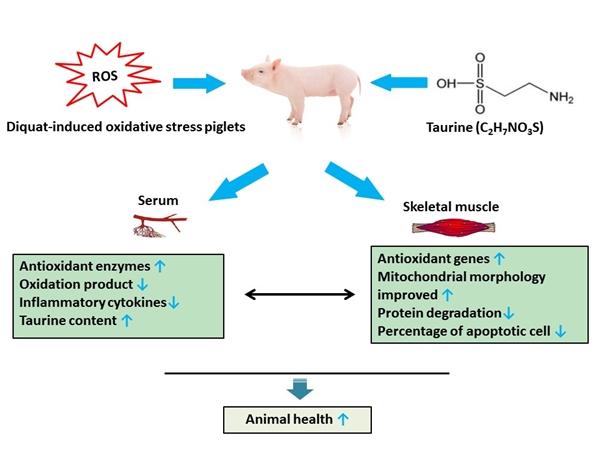- You are here: Home > Research > Research Progress
Oxidative stress has a negative effect on muscle mass, intestinal homeostasis, and hepatic function of weaned piglets. It depresses the growth performance causing a serious economic loss. Many factors contribute to oxidative stress, such as weaning. However, oxidative stress occurs throughout animal life and can’t be avoided. Therefore, it is urgent to find a way to alleviate oxidative stress in piglets.
Taurine plays protective roles in energy metabolism, tissue damage, and antioxidant. Two sources contribute to taurine content in the body: uptake from diets and biosynthesis. However, the taurine biosynthetic ability is limited. Taurine deficiency creates a vicious circle promoting the imbalance of energy metabolism.
Under oxidative stress conditions, the level of serum taurine exerts a tendency to decrease in piglets and the mRNA and protein expression levels of taurine transporters are significantly increased in the jejunum. These results suggest that the requirement of taurine is increased. It’s necessary to supplement additional taurine in the diet under oxidative stress conditions. Taurine has broad application prospects in the field of healthy animal husbandry as one of the green additives. However, the molecular mechanisms involved still remains unclear.
A scientific research team (Research Center of Livestock Ecology and Healthy Production) led by academician Yulong Yin from the Institute of Subtropical Agriculture (ISA) of the Chinese Academy of Sciences using diquat-challenged oxidative stress piglet model and additional taurine supplement in the diet to study the potential protective mechanisms of taurine in 35 days weaned piglets and got important findings.
They found that the diet supplemented with 0.60% taurine could effectively depress the decrement of piglets’ growth performance caused by diquat-induced oxidative stress, through suppressing the protein degradation pathway of the skeletal muscle tissue, improving the activity of antioxidant enzymes and the mRNA and protein expression levels related to the antioxidant process (Figure 1), alleviating intestinal injury by mediating tight junction barriers.
Besides, taurine is participated in regulating the free amino acid profile and taurine homeostasis in body fluid (serum and urine) and main tissues (skeletal muscle and liver). What’s more, there is a complex interaction between taurine transport and biosynthesis in skeletal muscle, intestine, and liver. Further research is needed to invest the protective mechanisms of taurine against oxidant damage in skeletal muscle and intestine using the multi-omics joint analysis method.
These findings establish the theoretical foundation for the scientific application of taurine in the diet of weaned piglets and offer technical support for healthy livestock production and accurate nutrition.
The research was supported by National Key R&D Program (2018YFD0500405), the Youth Innovation Promotion Association CAS (2016326), and the Earmarked Fund for China Agriculture Research System (CARS-35).
These studies have been published in Molecular Nutrition & Food Research, Journal of Animal Science and Biotechnology, Journal of Functional Foods, Frontiers in Physiology, and details could be found at https://onlinelibrary.wiley.com/doi/full/10.1002/mnfr.201800536, https://jasbsci.biomedcentral.com/articles/10.1186/s40104-020-00463-0, https://www.sciencedirect.com/science/article/pii/S1756464619304931, https://www.ncbi.nlm.nih.gov/pmc/articles/PMC7270355/.
Contact: Li Fengna
E-mail: lifengna@isa.ac.cn
Institute of Subtropical Agriculture, Chinese Academy of Sciences

Fig. 1. The potential pathway of taurine against oxidant injury of skeletal muscle. (Image by Li Fengna)
Address: Mapoling of Changsha City, Hunan province, P.R.China.Tel: +86-731-4615204 Fax: +86-731-4612685

